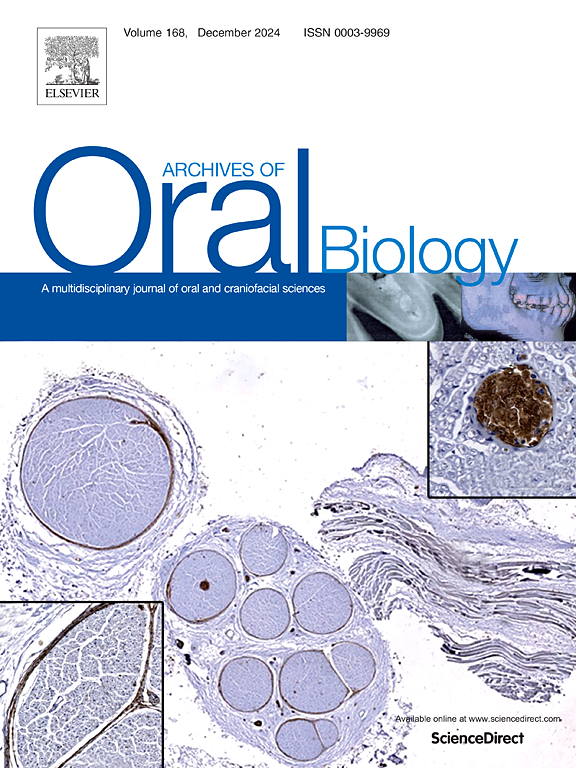Association between estrogen receptors polymorphisms and temporomandibular joint disorders: A systematic review
IF 2.2
4区 医学
Q2 DENTISTRY, ORAL SURGERY & MEDICINE
引用次数: 0
Abstract
Objectives
This systematic review aimed to investigate the association between genetic polymorphisms in estrogen receptor alpha (ERα) and beta (ERβ) and the presence and severity of temporomandibular disorders (TMDs).
Materials and methods
A comprehensive search was conducted in PubMed, Scopus and Web of Science on October 19, 2024, without language or time restrictions. Studies were included if they were cross-sectional, case-control, or cohort designs and reported data on ER-polymorphisms and TMDs, diagnosed using validated criteria. Two independent reviewers screened the results to identify eligible studies. Data were extracted and synthesized narratively due to high heterogeneity across included studies, with a subgroup analysis performed to evaluate the influence of sex. The risk of bias was assessed using the Joanna Briggs Institute's critical appraisal tools.
Results
The search identified 277 articles, of which 8 studies met the inclusion criteria. Seven were case-control and two cross-sectional studies. The most commonly investigated ER polymorphisms were ESR1 (Pvu II and Xba I) and ESR2 (rs1676303). Some studies identified associations between specific polymorphisms and TMD-related pain or joint conditions, although results varied across different populations and subtypes of TMDs.
Conclusions
The findings suggest potential associations between specific ERα and ERβ polymorphisms and TMD risk, particularly in women. However, inconsistencies across studies underscore the need for prospective and larger studies to confirm these genetic links and clarify their clinical significance.
Systematic Review Registration
CRD42024581266
雌激素受体多态性与颞下颌关节紊乱之间的关系:系统综述。
研究目的本系统综述旨在研究雌激素受体α(ERα)和β(ERβ)的基因多态性与颞下颌关节紊乱症(TMDs)的存在和严重程度之间的关联:2024 年 10 月 19 日,我们在 PubMed、Scopus 和 Web of Science 上进行了全面搜索,没有语言或时间限制。如果研究采用横断面、病例对照或队列设计,并报告了有关ER多态性和TMD的数据,且使用有效标准进行了诊断,则纳入研究。两名独立审稿人对结果进行了筛选,以确定符合条件的研究。由于纳入研究的异质性较高,因此对数据进行了提取和综合叙述,并进行了亚组分析以评估性别的影响。使用乔安娜-布里格斯研究所的批判性评估工具对偏倚风险进行了评估:搜索共发现 277 篇文章,其中 8 项研究符合纳入标准。其中七项为病例对照研究,两项为横断面研究。最常调查的 ER 多态性是 ESR1(Pvu II 和 Xba I)和 ESR2(rs1676303)。一些研究发现了特定多态性与 TMD 相关疼痛或关节状况之间的关联,但不同人群和亚型 TMD 的结果各不相同:研究结果表明,特定的 ERα 和 ERβ 多态性与 TMD 风险之间可能存在关联,尤其是在女性中。然而,各项研究之间的不一致性突出表明,需要进行前瞻性和更大规模的研究,以确认这些遗传联系并明确其临床意义:CRD42024581266。
本文章由计算机程序翻译,如有差异,请以英文原文为准。
求助全文
约1分钟内获得全文
求助全文
来源期刊

Archives of oral biology
医学-牙科与口腔外科
CiteScore
5.10
自引率
3.30%
发文量
177
审稿时长
26 days
期刊介绍:
Archives of Oral Biology is an international journal which aims to publish papers of the highest scientific quality in the oral and craniofacial sciences. The journal is particularly interested in research which advances knowledge in the mechanisms of craniofacial development and disease, including:
Cell and molecular biology
Molecular genetics
Immunology
Pathogenesis
Cellular microbiology
Embryology
Syndromology
Forensic dentistry
 求助内容:
求助内容: 应助结果提醒方式:
应助结果提醒方式:


